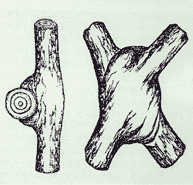Arthur Wiechula

Arthur Wiechula (January 20, 1867 – 1941) was a German landscape engineer. His marriage to Lydia Lindnau, produced three children, Margarethe (1895), Max (1897) and Ernst (1900).[1]
He received the German Royal State Inventor's Honor Cross. In 1926, he published Wachsende Häuser aus lebenden Bäumen entstehend [2] (Developing Houses from Living Trees) in German,[3][4] describing simple building techniques involving guided grafting together of live branches; including a system of v-shaped lateral cuts used to bend and curve individual trunks and branches in the direction of a design, with reaction wood soon closing the wounds to hold the curve.[3]
He envisioned growing trees so that it constituted walls during growth, thereby enabling the use of young trees for building.[3] He never built a living home, but he grew a 394-foot (120 m) wall of Canadian poplars to help keep the snow off of a section of train tracks.[4] His illustrated ideas have inspired many other artists to attempt to grow living homes out of trees.
See also
- Tree Shaping
- Topiary
- Espalier
- Pleaching
- Bonsai
- John Krubsack
- Axel Erlandson
- Dr Christopher Cattle
- Richard Reames
- Fab Tree Hab: Living Home of Shaped Trees
- Gilroy Gardens: Home of the Circus Trees
- Full Grown
References
- ↑ Kirsch, Konstantin (1996), Naturbauten aus lebenden Geholzen (Nature House Building) (3 ed.), OLV, Organischer Landbau-Verl. Lau, p. 82, ISBN 978-3-922201-17-5
- ↑ Wiechula, Arthur (1926), Wachsende Häuser aus lebenden Bäumen entstehend (Developing Houses from Living Trees), Verl. Naturbau-Ges, p. 320
- 1 2 3 "designboom: history of arborsculpture".
- 1 2 Link, Tracey (June 13, 2008), Arborsculpture: An Emerging Art Form and Solutions to our Environment (PDF), Senior project for Bachelor of Science degree in Landscape Architecture, p. 15